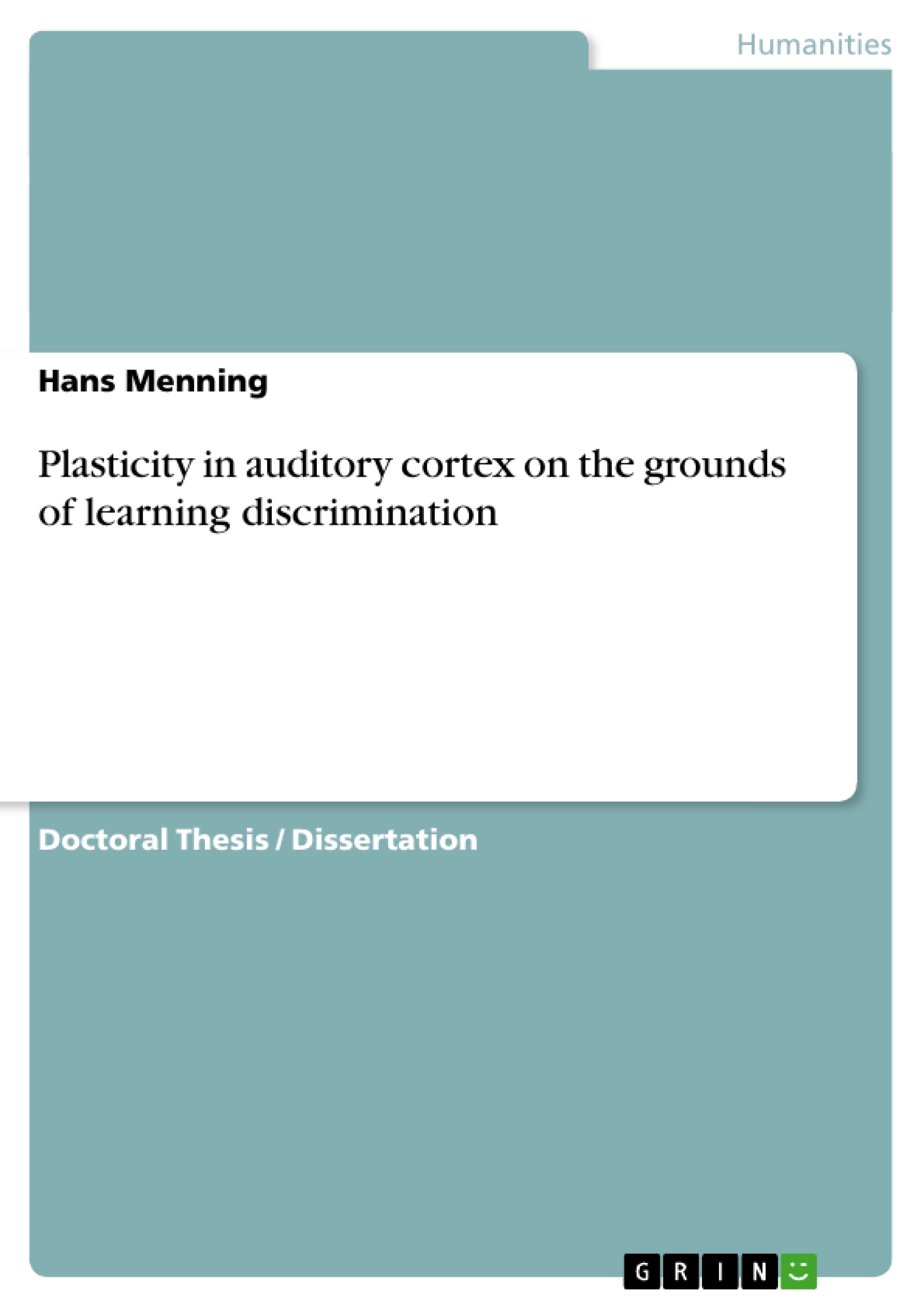The motivation for this thesis came from the intriguing idea that we continuously restructure our brain through everyday learning. How can this highly complex, highly adaptive “learning device” change and reorganize itself all the time while keeping the illusion that we are constantly “ourselves”? The question is, whether learning has the power to trigger functional and structural changes in the brain. Several levels of thinking are involved in an interdisciplinary way. Thus, on a psychological level, 3 major topics enter this work: learning, memory and preconscious or pre-attentive perception and processing of information. Pre-attentive perception means that the subjects' attention and awareness is not mirrored in the neuronal response at a great deal. Learning is involved in this study as an improving discrimination of fine frequency and word duration differences; the latter was examined in a group of native and non-native speakers. Memory is referred to as sensory memory, a short-time memory trace that is established through the repetition of the same “standard” stimulus. In the auditory modality this has been termed “echoic memory”. A long, repetitive training engraves deep “traces” into the memory. The lifelong training of one’s native language results in a very fast and highly automated long-term memory access. On a neurophysiological level the main topics are plasticity and the reorganization of the underlying representational brain areas. Plastic changes on a molecular, synaptic and neuronal level and reorganization of cortical “maps” have been demonstrated abundantly in animal studies. On a physical level the measured magnetic fields and the calculation of the source parameters of their underlying neural generators are discussed in the light of the neurophysiological and psychological phenomena. Therefore, the aim of this dissertation thesis was, to transfer the insights of animal plasticity research onto the human brain and to draw a connection line between discrimination learning and the underlying neurophysiological changes. In a second step, these effects of discrimination learning are tested on speech perception.
Inhaltsverzeichnis (Table of Contents)
- Introduction
- Overview
- Delimitation of the topic
- Theoretical framework
- Cortical Plasticity
- Basic principles of cortical plasticity
- Synaptic plasticity - the weighting of synaptic strength
- Long-term potentiation
- Long-term depression
- Axonal sprouting
- Neurogenesis in enriched environments
- From synapses to representational maps
- Reorganization of cortical maps by deprivation
- Reorganization after lesions in sensory areas
- Experience-dependent plasticity
- Reorganization of cortical maps after training
- Reorganization of cortical maps in experienced learners
- From cell assemblies to spatiotemporal patterns
- Perceptual discrimination learning
- Discrimination learning
- Perceptual learning
- Auditory sensory memory
- Conclusions
- Methodology
- Basic Principles of MEG
- Event Related Potentials and Fields
- Dipole source model
- The sensitivity of AERs for change
- The Mismatch Negativity
- The MMN change detection mechanism
- Sources of MMN
- Differential Impact of Native Language on the MMN
- Conclusions
- Experimental work
- Experiment 1: Plastic changes as a result of frequency discrimination learning
- Theoretical framework
- Materials and Methods
- Subjects
- The impact of discrimination learning on brain plasticity
- The role of the auditory cortex in learning and perception
- The neuromagnetic correlates of auditory processing
- The influence of native language on auditory perception
- The potential for training to enhance auditory skills
- Experiment 1 examines the effect of a three-week frequency discrimination training program on the N1m and Mismatch Field (MMF) responses in the brain. This experiment explores how the brain's ability to detect changes in sound frequencies develops with intensive training.
- Experiment 2 investigates the neural traces of learning non-native mora-timing patterns. German participants learn to discriminate Japanese word pairs, analyzing how the MMF and reaction times change with training.
- Experiment 3 explores the influence of native language on short-term plasticity. Japanese native speakers undergo the same mora-timing discrimination training as the German participants, revealing differences in the MMF and other brain responses.
Zielsetzung und Themenschwerpunkte (Objectives and Key Themes)
This dissertation examines the impact of intensive discrimination learning on the plasticity of the auditory cortex in humans. It investigates whether training in recognizing subtle frequency differences or learning non-native mora-timing patterns leads to observable changes in the brain's responses. The study uses magnetoencephalography (MEG) to measure the neuromagnetic correlates of these changes.
Zusammenfassung der Kapitel (Chapter Summaries)
The dissertation begins with an overview of the theoretical framework for cortical plasticity and how it relates to auditory perception and learning. The methodologies used in the study are described, with a focus on MEG and its ability to detect changes in brain activity. The main body of the work presents three experiments:
Schlüsselwörter (Keywords)
The central concepts explored in this dissertation include auditory perception, cortical plasticity, discrimination learning, magnetoencephalography (MEG), Mismatch Negativity (MMN), frequency discrimination, mora-timing, native language, and neuromagnetic responses. These keywords highlight the intersection of cognitive processes, brain activity, and the impact of experience on neural function.
- Citar trabajo
- Hans Menning (Autor), 2002, Plasticity in auditory cortex on the grounds of learning discrimination, Múnich, GRIN Verlag, https://www.grin.com/document/33623



